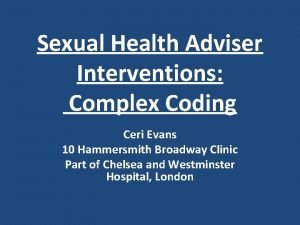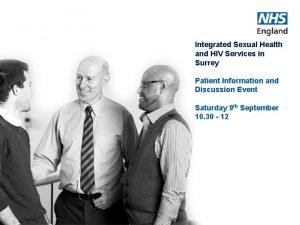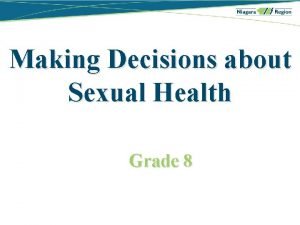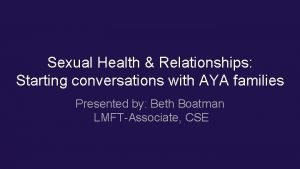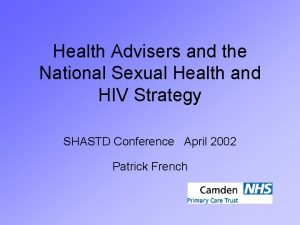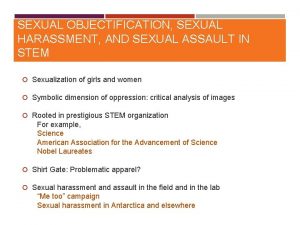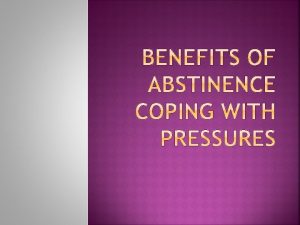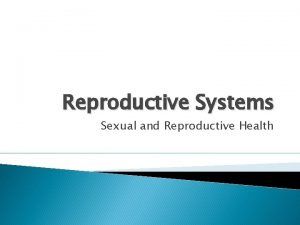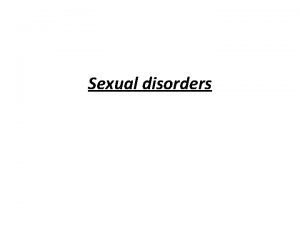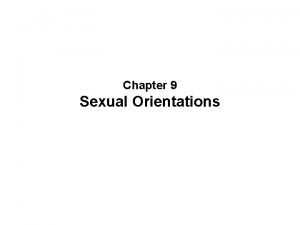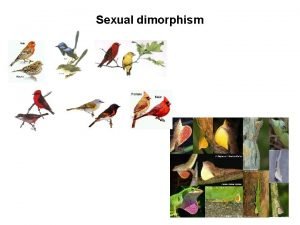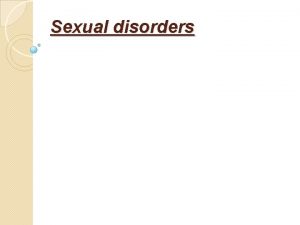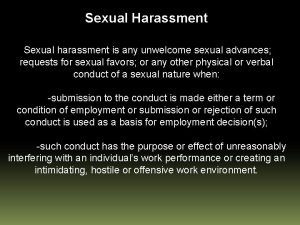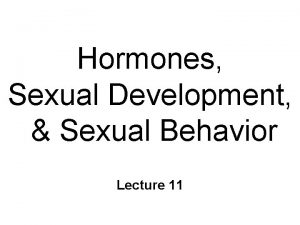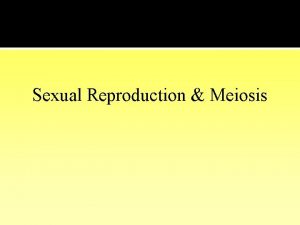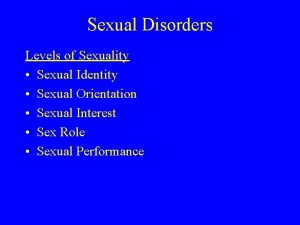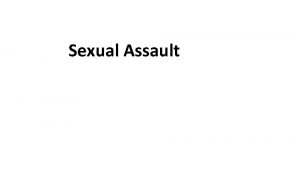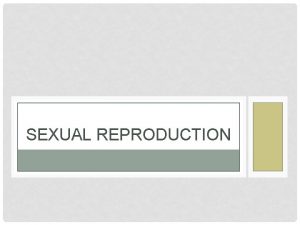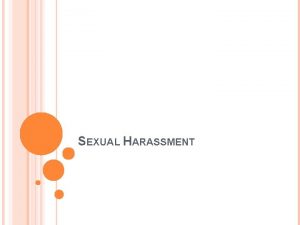Sexual Health and the College Student Sexual Health





















- Slides: 21

Sexual Health and the College Student

Sexual Health Defined Physical, emotional, mental, and social well- being Not merely the absence of disease Requires a positive approach -("Defining sexual health, " 2006)

Target Population Traditional Ages college-aged students 18 -25 Diverse Young nation group with just as diverse individuals adults attending college across the

Common Goals Healthy People 2020 Improve the healthy development, health, safety, and well-being of adolescents and young adults Improve pregnancy planning and spacing, and prevent unintended pregnancy. Promote healthy sexual behaviors Create social and physical environments that promote good health for all. ("Healthy people 2020, " 2013)

Demographics Young adults ages 18 to 25 attending a college in the United States First time out on their own Predominant age for binge drinking Excessive Stress A time to experiment Expectations of a “party-culture”

Cultural Descriptors High stress lifestyle No parental supervision Parties Poor sleep cycles Drug and alcohol use Increased incidence of casual sex

Biases Men typically report having casual sex, or “hooking up, ” more often People often overestimate their peers’ sexual activities STDs Homosexuality and AIDS Blacks overrepresented -(Clark, 2001) -(Owen, Rhoades, Stanley, & Finchman, 2010) -(Younge, Corneille, Lyde, & Cannaday, 2013)

Health-Risk Factors General risk factors Smoking, drinking, stress, illicit use of drugs, gambling, depression, and weight gain Risk factors for hookups Intentions, impulsivity, thrill-seeking, previous hookups, drug and alcohol use, and other situational triggers -(Fielder, Walsh, Carey, & Carey, 2013)

Health-Risk Factors Post-hookup risk factors Pregnancy Sexually transmitted diseases Negative social responses Negative emotional consequences Low self-esteem -(Fielder, Walsh, Carey, & Carey, 2013)

Sociodeterminants Race, status, attitude, mental health, cigarette use, academic achievement, relationship status… Not consistent predictors of sexual hookups More research is needed -(Fielder, Walsh, Carey, & Carey, 2013)

Statistics One in four college students had an STD Only 54% of students regularly use condoms during vaginal intercourse 80% of people who have a sexually transmitted disease experience no noticeable symptoms - (Nursing Schools, 2010)

Statistics Only 60% of women know how to use a condom correctly and a whopping 60% also say they would still have sex even if their partner refused to wear a condom HIV/AIDS is now considered the leading cause of death for individuals aged 15 to 24 years of age. The most affected persons within this age group are college students - (Nursing Schools, 2010)

Statistics In one survey 60% of women reported that they are in committed relationships while only 38% of men reported the same More than half the participants in a study done among college students believe they can tell if someone has an STI just by looking at them - (Nursing Schools, 2010)

Health Belief Model Describes a person’s health behavior as an expression of health beliefs Designed to predict one’s health behavior Consists of perceived benefits, barriers, and stimuli -(Farlex, 2013)

Health Belief Model One study applied this to discover students’ beliefs about sexual risk taking 71 students at a large Midwestern University whom have had at least one hookup Predominately white, Christian, heterosexuals Assessed students’ perception of sexual norms, the events prior to the hookup, their evaluation of the experience, and perceptions of the risk -(Downing-Matibag & Geisinger, 2009)

Health Belief Model Results were analyzed with the HBM In order for an individual to take preventative action, they must: Believe they are at risk Think adverse effects are undesirable Accept prevention is a better alternative Seek attainable prevention actions 50% were concerned about STDs -(Downing-Matibag & Geisinger, 2009)

Health Belief Model In other words…

Wrapping it up 18 -25 year old students are at risk for many complications involving sex They are made of a very diverse demographic Some biases exist that skew information Many students are severely under-informed about the risks STDs are more prevalent than they seem Preventative action can be assessed with the Health Belief Model

References CDC Office of Women’s Health (2012, August 20). College Health and Safety. http: //www. cdc. gov/family/college/ Centers for Disease Control and Prevention. (2012, June 20). Sexual Risk Behavior: HIV, STD, & Teen Pregnancy Prevention. http: //www. cdc. gov/ Healthy. Youth/sexualbehaviors/ Clark, S. (2001). Parents, peers, and pressure: Identifying the influences on responsible sexual decision-making. Adolescent Health, 2(2), Retrieved from http: //www. naswdc. org/practice/adolescent_health/ah 0202. asp Crocker, S. (2012, September 18). Thoughts on the intersection of race, religion, politics, ministry, sports and culture. In Crocker Chronicle: 2012 Demographics For U. S. College Students. Retrieved July 16, 2013, from http: //crockerchronicle. blogspot. com/2012/09/2012 -demographics-for-us college. html Downing-Matibag, T. , & Geisinger, B. (2009). Hooking up and sexual risk taking among college students: a health belief model perspective. Qualitative Health Research, 19(9), 1196 -1209. doi: 10. 1177/1049732309344206. Retrieved from CINAHL.

References Farlex. (2013). Health belief model. In The Free Dictionary. Retrieved July 15, 2013, from http: //medical-dictionary. thefreedictionary. com/health+belief+model Fielder, R. L. , Walsh, J. L. , Carey, K. B. , & Carey. M. P. (2013). Predictors of Sexual Hookups: A Theory-Based, Prospective Study of First-Year College Women. Center for Health and Behavior and Department of Psychology. Retrieved from Pub. Med. Taylor, C. R. , Lillis, C. , Le. Mone, P. , & Lynn, P. (2011). Fundamentals of Nursing: The Art and Science of Nursing Care (7 th ed. , p. 72). Philadelphia, PA: Wolters Kluwer Health-Lippincott Williams & Wilkins. Mongkue, M. Y. , Mushi, R. J. , & Thomas, R. (2010) Perception of HIV/AIDS and sociocognitive determinants of safe sex practices among college students attending a historically black college and university in the United States of America. Journal of AIDS and HIV Research, 2(3) 032 -047. Retrieved from http: //www. academicjournals. org/JAHR/ Nursing Schools. (2010, May 17). 10 Truly Shocking Stats On STDs and College Students. http: //www. nursingschools. net/blog/2010/05/10 -truly-shockingstats-on-stds-and-college-students/

References Owen, J. J. , Rhoades, K. G. Stanley, S. M. , & Fincham, F. D. (2010). “Hooking Up” Among College Students: Demographic and Psychosocial Correlates. Archives of Sexual Behavior, 39(3), 653 -663. DOI 10. 1007/s 10508 -008 -9414 -1 Younge, S. N. , Corneille, M. A. , Lyde, M. , & Cannaday, J. (2013) The Paradox of Risk: Historically Black College/University Students and Sexual Health. Journal of American College Health, 61(5), 254 -262.
 Sexual health and relationships education scotland
Sexual health and relationships education scotland Sexual health adviser
Sexual health adviser Gum clinics surrey
Gum clinics surrey What is sexual health
What is sexual health Sexual health
Sexual health Amsa sexual health leadership course
Amsa sexual health leadership course Society of sexual health advisers
Society of sexual health advisers Monday tuesday is my weekend
Monday tuesday is my weekend We ...... a big piece of wood last saturday. (see)
We ...... a big piece of wood last saturday. (see) Uheaa contact
Uheaa contact Class maths student student1 class student string name
Class maths student student1 class student string name National student clearinghouse student tracker
National student clearinghouse student tracker Freckle student
Freckle student Students good morning
Students good morning Student leaning space
Student leaning space Hình ảnh bộ gõ cơ thể búng tay
Hình ảnh bộ gõ cơ thể búng tay Lp html
Lp html Bổ thể
Bổ thể Tỉ lệ cơ thể trẻ em
Tỉ lệ cơ thể trẻ em Chó sói
Chó sói Glasgow thang điểm
Glasgow thang điểm Alleluia hat len nguoi oi
Alleluia hat len nguoi oi

